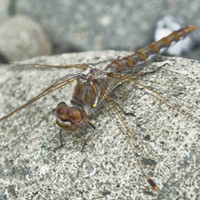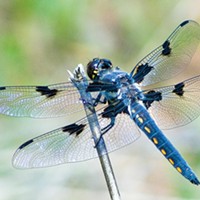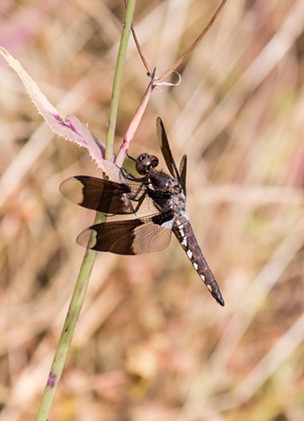Sunday, June 21, 2015
HumBug: Artful Dodgers
Posted By Anthony Westkamper on Sun, Jun 21, 2015 at 3:00 PM
Today, faced with the humdrum task of taking old stuff out to the compost bin, I grabbed a camera on the off chance I might see something more interesting than rotten potato peels. Flying low and fast, dodging between grass stalks and tangled branches was a Common Whitetail (Plathemis lydia). With their dark wingspots, agile flight and bright markings, they remind me of old fashioned bi-planes.
There are some standout features that make it an easy species to identify. This particular specimen was a young male. You can tell his age because throughout their adult life they progress through several stages. They start out as brown with yellow spots. As they age, a stark white, chalky coating called “prunosity” gradually covers their bodies and parts of the wings. If they live long enough, wear and tear rubs off some of the whiteness in spots. Females have similar brown markings, get little or no prunosity and have different wing-spots.
They range from Canada to Mexico, and throughout the U.S. Alighting close to the ground, they hunt by “hawking,” dashing up and back again to capture small flying insects like mosquitoes.
Many birders are adding the odenates (Members of the order of Dragonflies and Damselflies) to their ornithological quests. The delights are about the same, the subjects often allow you to get quite close and the tools and techniques are similar. That is not to say they are abandoning their feathered friends, but adding another thing to enjoy in the great outdoors.
While no paraphernalia is necessary to admire the beauty and flying prowess of dragonflies, you might want a set of binoculars, a butterfly net and a hand lens. I warn you, however, capturing a dragonfly on the wing on a warm day can be challenging. They are very quick and, unlike us, their nerve impulses only have a few inches to travel.
A pocket field guide like the Common Dragonflies of California by Kathy Biggs is handy. For further reading there is (in order of size and expense) Dragonflies and Damselflies of Oregon by Cary Kerst and Steve Gordon (Oregon is close enough and I have yet to find a species which was not listed in this book), Dragonflies and Damselflies of the West by Dennis Paulson, and lastly the very technical overview of nearly everything known about dragonflies and damselflies throughout the world Dragonflies Behavior and Ecology of Odonata by Philip S. Corbet, which is thick and dense.
There are some standout features that make it an easy species to identify. This particular specimen was a young male. You can tell his age because throughout their adult life they progress through several stages. They start out as brown with yellow spots. As they age, a stark white, chalky coating called “prunosity” gradually covers their bodies and parts of the wings. If they live long enough, wear and tear rubs off some of the whiteness in spots. Females have similar brown markings, get little or no prunosity and have different wing-spots.
They range from Canada to Mexico, and throughout the U.S. Alighting close to the ground, they hunt by “hawking,” dashing up and back again to capture small flying insects like mosquitoes.
Many birders are adding the odenates (Members of the order of Dragonflies and Damselflies) to their ornithological quests. The delights are about the same, the subjects often allow you to get quite close and the tools and techniques are similar. That is not to say they are abandoning their feathered friends, but adding another thing to enjoy in the great outdoors.
While no paraphernalia is necessary to admire the beauty and flying prowess of dragonflies, you might want a set of binoculars, a butterfly net and a hand lens. I warn you, however, capturing a dragonfly on the wing on a warm day can be challenging. They are very quick and, unlike us, their nerve impulses only have a few inches to travel.
A pocket field guide like the Common Dragonflies of California by Kathy Biggs is handy. For further reading there is (in order of size and expense) Dragonflies and Damselflies of Oregon by Cary Kerst and Steve Gordon (Oregon is close enough and I have yet to find a species which was not listed in this book), Dragonflies and Damselflies of the West by Dennis Paulson, and lastly the very technical overview of nearly everything known about dragonflies and damselflies throughout the world Dragonflies Behavior and Ecology of Odonata by Philip S. Corbet, which is thick and dense.
Speaking of...
-

HumBug: Winter Insects
Feb 16, 2020 -

HumBug: The Current Mass Extinction
Jan 19, 2020 -

Best of the Bugs
Jan 2, 2020 - More »
Readers also liked…
more from the author
-
HumBug: Early Spring Pollinators
- Apr 12, 2020
-
HumBug: A Recipe for History
- Apr 5, 2020
-
HumBug: Bugs in the City
- Mar 29, 2020
- More »


































